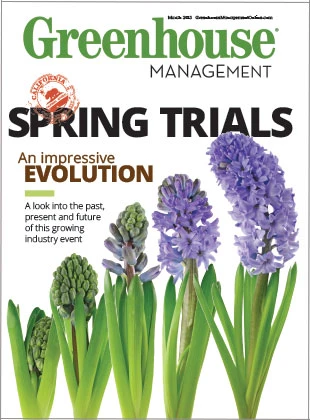 This double-blooming series of dianthus flowers early and stays in bloom. And when night temperatures drop in late summer, it re-blooms. Available in five varieties, Dianthus EverLast grows between 8 and 12 inches in height, and 10 and 14 inches in spread. It has a mounding habit and requires sun exposure. The series is also the most cold-hardy crop in the Selecta assortment.
This double-blooming series of dianthus flowers early and stays in bloom. And when night temperatures drop in late summer, it re-blooms. Available in five varieties, Dianthus EverLast grows between 8 and 12 inches in height, and 10 and 14 inches in spread. It has a mounding habit and requires sun exposure. The series is also the most cold-hardy crop in the Selecta assortment.
For more: Selecta, (800) 879-2255; selectanorthamerica.com
 Production:
Production:
- 25/35 mm is the recommended cell size for rooting.
- Maintain soil temperature at 70°F until cuttings are well-rooted. Keep temperature high after planting the liner, until roots have developed nicely.
- Average propagation is five to six weeks.
- Pinching during propagation is recommended.
- Root system is sensitive, so keep plants hydrated, but avoid overwatering young plants.
- PGR treatment after seven to 10 days is not recommended. The use of PGRs during finishing is optional.
- Keep pH between 6.2 and 6.5, and EC between 1.4 and 1.8.
- Allow media to become dry before irrigation.
- Use 100-150 ppm N fertilizer. Low concentrations should be used after roots show. Increase concentrations as plants develop to the recommended levels.
- Keep temperature at 65-70°F during the day and at 50-55°F at night.
- If using unpinched liners, pinch after transplanting. This should occur when buds are visible and side shoots start to develop.
- Keep light levels at 5,000 to 6,000 foot-candles. High light levels with cool temperatures will improve plant quality.
Did you know?
The use of “cool morning” treatments will improve plant quality.

Explore the March 2013 Issue
Check out more from this issue and find your next story to read.
Latest from Greenhouse Management
- The Growth Industry Episode 3: Across the Pond with Neville Stein
- A nation of gardeners: A history of the British horticulture industry
- How Izel Native Plants is solving the native plant conundrum
- Trends: Proven Winners 2025 perennial survey shows strong demand
- Online registration opens for 2025 Farwest Show
- Cashing in with customization
- The Ball Seed Difference
- Lawsuit challenges new H-2 visa rules





